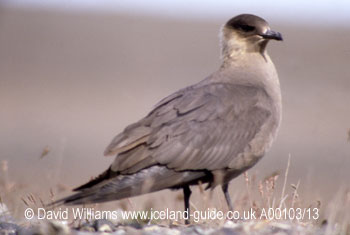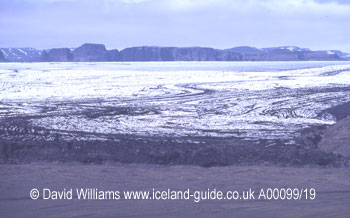 |
| This
picture of a great skua was taken beside Jökulsárlón
farther eastwards along the south coast. These big birds can weigh as much as 1,600g and there around 6,000 breeding pairs in Iceland, most of which are found on the wide expanses of the sandur on the south coast. Its Latin name is Stercorarius skua. Its other names are: skúmur (Icelandic), storkjove (Danish), grande labbe (French) and großraubmöwe (German). |
 |
| This is the tall black snout of Skeiðarárjökull. The jet black colour is due to all the sand and gravel held within the ice and which is consequently dumped as the ice melts. Much of this material is then carried seawards by the cold glacial rivers. |
I pressed
on, eager to reach the glacier`s snout. Then, suddenly, a large dark object
flew over my head, just centimetres above me. There had been no warning
sound; no cry, no shriek, just a sudden menacing attack. My heart sank
as I belatedly remembered that Skeiðarársandur
was home to the Northern Hemisphere`s largest colony of breeding great
skuas - three thousand of these huge aggressive birds. And nowhere to
shelter.
The bird circled and came back towards me. My heart raced, remembering
what I had read. They could go for your head with their large, strong
beaks; they could also hit you with their muscular feet. Should I run?
But where? I had passed the hut ten minutes ago so that was too far away.
The bird dived again and all I could do was raise my arm to keep the attacker
away from my face. This happened a couple of more times but just before
the next attack I nervously held my camera bag aloft and the bird, obviously
upset by this change of target, veered away and left me alone. My heart
calmed down and I got back to business. There was a glacier to be seen.
Time to explore.
Postscript
This was my very first encounter with great skuas. They are nasty, aggressive
birds which I came across on other occasions during my travels in Iceland.
They frequently chase smaller birds and force them to disgorge their food,
so other birds have good cause not to like them either.
I particularly remember seeing many dead puffins in Heimaey`s bay.
They had been killed "for fun" by great skuas, a practice that
has been noted in other northern countries.
My preferred method of preventing attacks is to carry a rucksack and to attach to it a 2 metre long stick with a bright yellow flag at the top. The skuas will try to attack but can`t get near because of the flag. I recall once having four or five of the birds trying to attack me while I was standing on a tall moraine in front of the Kvíárjökull glacier which is to the east of Skeiðarárjökull. None of the birds could get near me and I could safely stand there watching the birds and admiring the landscape. Success!
| Previous Page |